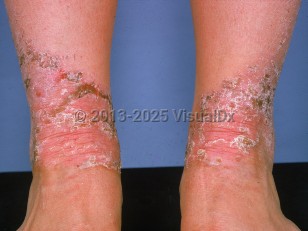Acquired acrodermatitis enteropathica in Adult
Alerts and Notices
Important News & Links
Synopsis

Acquired acrodermatitis enteropathica (AAE) is an acquired condition that occurs as a result of zinc deficiency. In AAE, skin manifestations may be accompanied by alopecia and diarrhea, but this classic triad is present in only 20% of cases. In mild to moderate deficiency, the clinical picture is that of thin, scaly plaques that may resemble psoriasis. With a more severe deficiency, it will manifest as a periorificial, acral, and intertriginous dermatitis that has eczematous features, but may also be vesiculobullous or even pustular. The eruption tends to be symmetrical.
It appears that zinc is required for the orderly proliferation of keratinocytes. Additionally, low tissue zinc is associated with the overproduction of inflammatory cytokines and reactive mediators.
The disease occurs in all age groups and there is no predilection by sex.
Decreased absorption of zinc is associated with inadequate dietary intake due to low caloric diets, anorexia nervosa, selective eating, vegetarian diets, and diets high in phytates that bind zinc (typical of cereal grain-based diets common to parts of the Middle East and North Africa). Total parenteral nutrition (TPN) with inadequate zinc supplement is a known cause of deficiency. Malabsorption related to inflammatory bowel disease (Crohn disease, ulcerative colitis), celiac sprue, cystic fibrosis, and numerous bariatric procedures also leads to zinc deficiency. Chronic diarrhea, along with chronic liver and/or renal disease (nephrotic syndrome), are each risk factors for deficiency.
Medications associated with zinc deficiency include proton pump inhibitors (decrease absorption) and loop diuretics (increase loss). Some angiotensin converting enzyme (ACE) inhibitors and calcium channel blockers have also been implicated.
Identical clinical findings may result from hereditary acrodermatitis enteropathica, a rare autosomal recessive disease caused by abnormal zinc absorption due to a transport deficiency across the small intestine.
It appears that zinc is required for the orderly proliferation of keratinocytes. Additionally, low tissue zinc is associated with the overproduction of inflammatory cytokines and reactive mediators.
The disease occurs in all age groups and there is no predilection by sex.
Decreased absorption of zinc is associated with inadequate dietary intake due to low caloric diets, anorexia nervosa, selective eating, vegetarian diets, and diets high in phytates that bind zinc (typical of cereal grain-based diets common to parts of the Middle East and North Africa). Total parenteral nutrition (TPN) with inadequate zinc supplement is a known cause of deficiency. Malabsorption related to inflammatory bowel disease (Crohn disease, ulcerative colitis), celiac sprue, cystic fibrosis, and numerous bariatric procedures also leads to zinc deficiency. Chronic diarrhea, along with chronic liver and/or renal disease (nephrotic syndrome), are each risk factors for deficiency.
Medications associated with zinc deficiency include proton pump inhibitors (decrease absorption) and loop diuretics (increase loss). Some angiotensin converting enzyme (ACE) inhibitors and calcium channel blockers have also been implicated.
Identical clinical findings may result from hereditary acrodermatitis enteropathica, a rare autosomal recessive disease caused by abnormal zinc absorption due to a transport deficiency across the small intestine.
Codes
ICD10CM:
E60 – Dietary zinc deficiency
SNOMEDCT:
12602008 – Acquired acrodermatitis enteropathica
E60 – Dietary zinc deficiency
SNOMEDCT:
12602008 – Acquired acrodermatitis enteropathica
Look For
Subscription Required
Diagnostic Pearls
Subscription Required
Differential Diagnosis & Pitfalls

To perform a comparison, select diagnoses from the classic differential
Subscription Required
Best Tests
Subscription Required
Management Pearls
Subscription Required
Therapy
Subscription Required
References
Subscription Required
Last Reviewed:03/03/2021
Last Updated:07/16/2025
Last Updated:07/16/2025
Acquired acrodermatitis enteropathica in Adult

